Risk management is a key component for a successful trading strategy which is often overlooked. By applying risk management techniques, traders can effectively reduce the detrimental effect losing positions have on the value of a portfolio.
Keep reading to learn more about:
- Why risk management is important
- How to manage risk in trading
- Trading risk management tools
Why is trading risk management important?
Many traders see trading as an opportunity to make money but the potential for loss is often overlooked. By implementing a risk management strategy, a trader will be able to limit the negative effects of a losing trade when the market moves in the opposite direction.
A trader who incorporates risk management into the trading strategy will be able to benefit from upside movement while minimizing downside risk. This is achieved through the use of risk management tools like stops and limits and by trading a diversified portfolio.
Traders that opt to forgo the use of trading stops run the risk of holding onto positions for too long in the hope that the market will turn around. This has been identified as the number one mistake traders make, and can be avoided by adopting the traits of successful traders to all trades.
How to Manage Risk in Trading: Top Tips and Strategies
Below are six risk management techniques that traders of all levels should consider:
- Determine the risk/exposure upfront
- Optimal stop loss level
- Diversify your portfolio: the lower the correlation, the better the diversification
- Keep your risk consistent and manage your emotions
- Maintaining a positive risk to reward ratio
1) Determine the risk/exposure upfront:
Risk is inherent in every trade which is why it is essential to determine your risk before entering the trade. A general rule would be to risk 1% of the account equity on a single position and no more than 5% across all open positions, at any time. For example, the 1% rule applied to $10,000 account would mean no more than $100 should be risked on a single position. Traders will then need to calculate their trade size based on how far away the stop is placed in order to risk $100 or less.
The benefit of this approach is that it helps to preserve the account equity after a run of unsuccessful trades. An additional benefit of this approach is that traders are more likely to have free margin available to take advantage of new opportunities in the market. This avoids having to forgo such opportunities due to margin being tied up in existing trades.
2) Optimal stop loss level
There are many different approaches that traders can utilize when deciding where to place a stop.
Traders can set stops in accordance with:
- Moving averages – set stops above (below) the specified MA for long (short) positions. The chart below shows how traders can use the moving average as a dynamic stop loss.
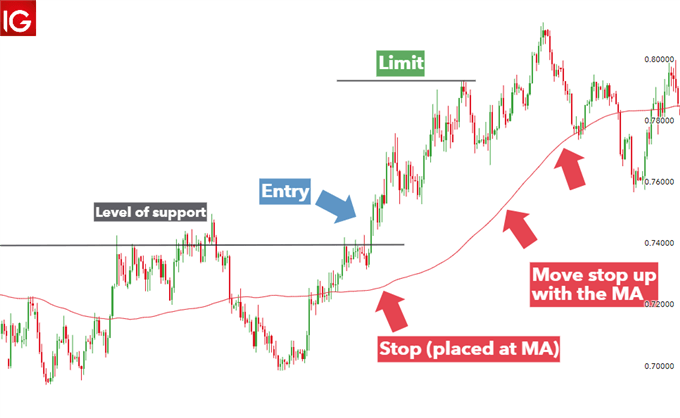
- Support and resistance – set stops below (above) support (resistance) for long (short) positions. The chart below shows the stop being placed below support in a ranging market , allowing the trade enough room to breathe while protecting against a large downward move.
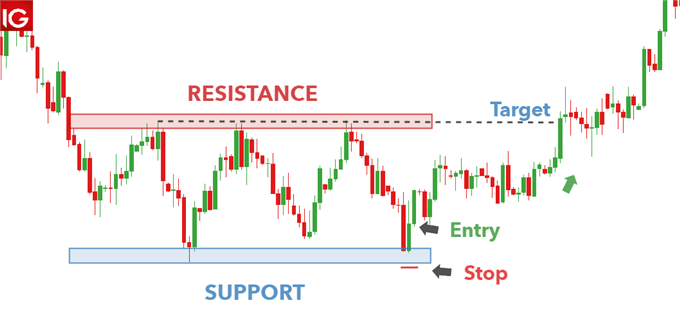
- Using the Average True Range (ATR) - ATR measures the average pip/point movement in any security over a specified period and provides traders with a minimum distance away to set their stops. The chart below adopts a cautious approach to the ATR by setting the stop distance in accordance with the maximum ATR reading from recent price action.
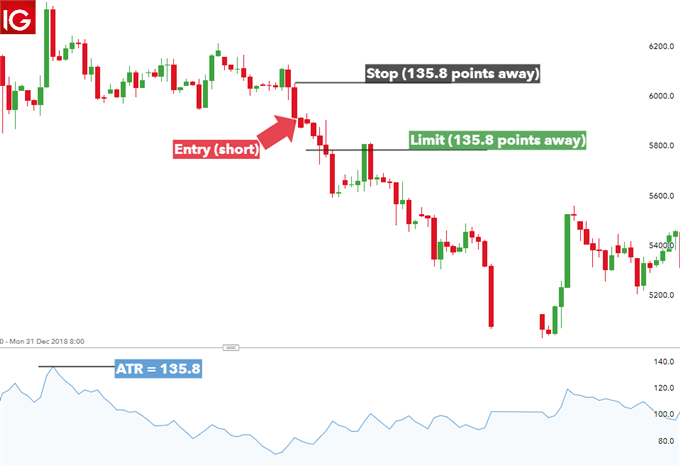
*Advanced Tip : Instead of using a normal stop loss, traders can use a trailing stop to mitigate risk when the market is moving in your favor. The trailing stop, as the name suggests, moves the stop loss up on winning positions while maintaining the stop distance, at all times.
3) Diversify your portfolio: The lower the correlation, the better the diversification
Even if the 1% rule is adhered to, it is crucial to know how positions may be correlated. For example, the EUR/USD and GBP/USD currency pairs have a high correlation, meaning they tend to move closely together and in the same direction. Trading highly correlated markets is great when trades move in your favour but becomes an issue on losing trades as the loss on the one trade now applies to the correlated trade too.
The chart below depicts the high correlation observed between EUR/USD and GBP/USD . Notice how closely the two price lines track each other.
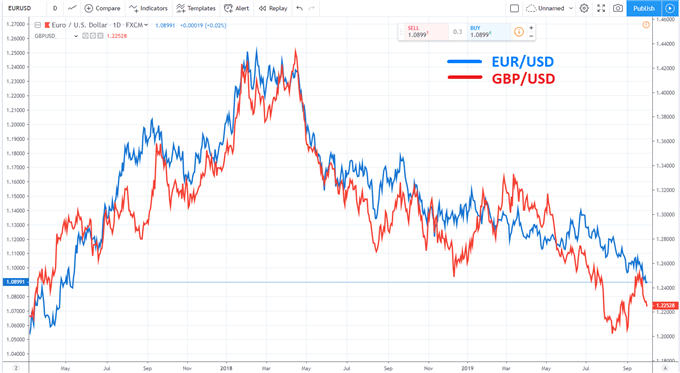
Having a good understanding of the markets you are trading and avoiding highly correlated currencies, helps to achieve a more diversified portfolio with reduced risk.
4) Keep your risk consistent and manage your emotions
Once traders make a few winning trades, greed can easily set in and entice traders to increase trading sizes. This is the easiest way to burn through capital and place the trading account in jeopardy. For more established traders however, it is alright to add to existing winning positions but maintaining a consistent framework when it comes to risk should be the general rule.
Fear and greed rear their ugly head many times when trading. Learn how to manage fear and greed in trading .
5) Maintaining a positive risk to reward ratio
Maintaining a positive risk to reward ratio is crucially important to managing risk over time. There may be losses early on but maintaining a positive risk to reward ratio and keeping to the 1% rule on each trade, greatly enhances the consistency of your trading account over time.
The risk to reward ratio calculates how many pips a trader is prepared to risk, compared with the number pips a trader will receive if the target/limit is hit. A 1:2 risk to reward ratio means that the trader is risking one pip to make two pips, if the trade works out.
The magic within the risk to reward ratio lies in its repeated use. We discovered in our Traits of Successful Traders research that the percentage of traders who used a positive risk to reward ratio tended to show profitable results versus those with a negative risk to reward ratio (page 7 of the guide). Traders can still be successful, even if they only win 50% of their trades, as long as a positive risk to reward ratio is maintained.
*Advanced Tip : Traders often get frustrated when the trade moves in the right direction only for the market to turn right around and trigger the stop. One way to avoid this happening is to make use of a two-lot system. This strategy looks to close out half of the position when it is midway to the target and then bring the stop on the remaining position to break-even. This way the traders gets to bank the profit on the one position while essentially being left with a risk-free trade in the remaining position (if using a guaranteed stop).
Trading risk management tools
1) Normal Stop Loss : These stops are the standard stops offered by most forex brokers. They tend to work best in non-volatile markets as they are prone to slippage . Slippage is a phenomenon where the market doesn’t actually trade at the specified price, either because there is no liquidity at that price or due to a gap in the market. As a result, the trader has to take the next best price, which may be significantly worse, as shown in the USD /BRL chart below:
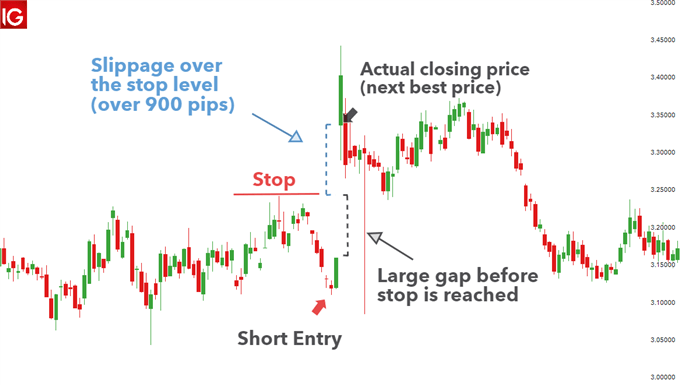
2) Guaranteed Stop Loss : A guaranteed stop eliminates the issue of slippage entirely. Even in volatile markets where price can gap, the broker will honor the exact stop level. However, this feature comes with a cost as brokers will charge a small percentage of the trade to guarantee the stop level.
3) Trailing Stop Loss : A trailing stop moves the stop closer to the current price on winning positions while maintaining the same stop distance at inception of the trade. For example, the GBP /USD chart below shows a short entry that moves favorably. Every time the market moves 200 pips the stop will automatically move along with it, while maintaining the initial stop distance of 160 pips.
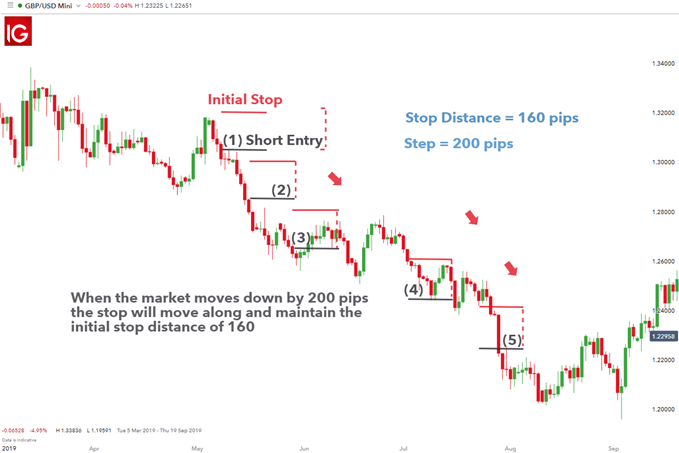
Further reading to improve your risk management skills
- Find out how leverage , risk-to-reward ratios and stops fit into the risk management process and why it is crucial for traders to have a solid grasp of these concepts.

